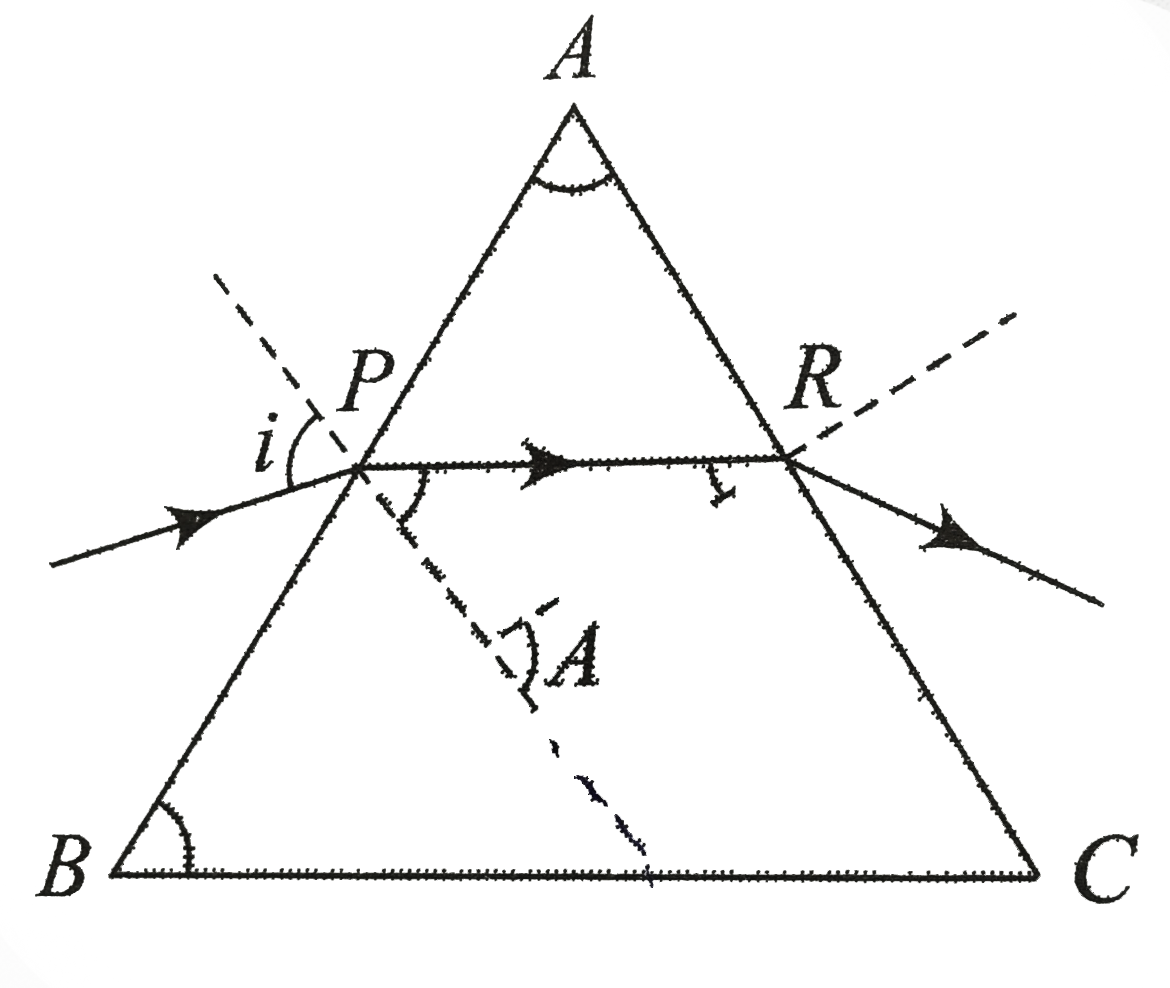A ray of light suffers a minimum deviation when incident on equilateral prism of refractive index √2 The angle of deviation is
30∘
45∘
60∘
50∘
The correct Answer is:A
To solve the problem of finding the angle of minimum deviation when a ray of light passes through an equilateral prism with a refractive index of √2, we can follow these steps:
Step 1: Understand the properties of an equilateral prism
An equilateral prism has three equal angles, each measuring 60∘. The angle of the prism is denoted as A, which is 60∘ in this case.
Step 2: Recall the condition for minimum deviation
In the condition of minimum deviation, the angle of incidence i is equal to the angle of emergence e. This means that the light ray enters and exits the prism symmetrically.
Step 3: Use the formula for refractive index
The refractive index n of the prism can be related to the angle of the prism A and the minimum deviation δm using the formula:
n=sin(A+δm2)sin(A2)
Here, A=60∘.
Step 4: Substitute the known values into the formula
Given that n=√2 and A=60∘, we can substitute these values into the formula:
√2=sin(60∘+δm2)sin(60∘2)
Calculating sin(60∘2):
sin(30∘)=12
Thus, the equation becomes:
√2=sin(30∘+δm2)12
This simplifies to:
√2=2sin(30∘+δm2)
sin(30∘+δm2)=√22
Step 5: Solve for δm
The value of sin(45∘)=√22, so we set:
30∘+δm2=45∘
Subtracting 30∘ from both sides gives:
δm2=15∘
Multiplying both sides by 2 results in:
δm=30∘
Conclusion
The angle of minimum deviation δm when a ray of light passes through an equilateral prism of refractive index √2 is 30∘.
An equilateral prism has three equal angles, each measuring 60∘. The angle of the prism is denoted as A, which is 60∘ in this case.
In the condition of minimum deviation, the angle of incidence i is equal to the angle of emergence e. This means that the light ray enters and exits the prism symmetrically.
The refractive index n of the prism can be related to the angle of the prism A and the minimum deviation δm using the formula:
n=sin(A+δm2)sin(A2)
Here, A=60∘.
Given that n=√2 and A=60∘, we can substitute these values into the formula:
√2=sin(60∘+δm2)sin(60∘2)
Calculating sin(60∘2):
sin(30∘)=12
Thus, the equation becomes:
√2=sin(30∘+δm2)12
This simplifies to:
√2=2sin(30∘+δm2)
sin(30∘+δm2)=√22
The value of sin(45∘)=√22, so we set:
30∘+δm2=45∘
Subtracting 30∘ from both sides gives:
δm2=15∘
Multiplying both sides by 2 results in:
δm=30∘
The angle of minimum deviation δm when a ray of light passes through an equilateral prism of refractive index √2 is 30∘.
Topper's Solved these Questions
Similar Questions
A ray of light undergoes deviation of 30degree when incident on an equilateral prism of refractive index √2. The angle made by the ray inside the prism with the base of the prism is …..
View SolutionA ray of light undergoes a deviation of 30∘ when incident on an equilateral prism of refractive index √2.
What is the angle subtended by the ray inside the prism with the base of the prism?

View Solution
Knowledge Check
A ray of light suffers a minimum deviation when incident on an equilateral prism of refractive index √2 The angle of incidence is
A30∘B45∘C60∘D50∘A ray of light suffers minimum deviation when incident on an equilateral prism of refractive index √2 . What is the angle of incidence ?
A30∘B45∘C60∘D90∘A ray of light undergoes deviation of 30∘ when incident on an equilateral prism of refractive index √2. The angle made by the ray inside the prism with the base of the prism is
A15∘B0∘C45∘D30∘
A ray of light undergoes deviation of 30∘ when incident on an equilateral prism of refractive index √2. what is the angle subtended by the ray inside the prism with the base of the prism?
View SolutionA ray of light undergoes deviation of 30∘ when incident on a n equilateral prism of refractive index √2. The and made by the ray inside the prism with the base of the prism is ________________.
View SolutionA light ray falls perpendicular on one face of an equilateral prism having refractive index √2 .The angle of deviation is :
View SolutionThe angle of minimum deviation is an equilateral prism of refractive index 1.414 is
View SolutionA ray of light is incident normally on one face of an equilateral prism of refractive index 1.5. The angle of deviation is: (Given sin−1.23=42∘)
View Solution